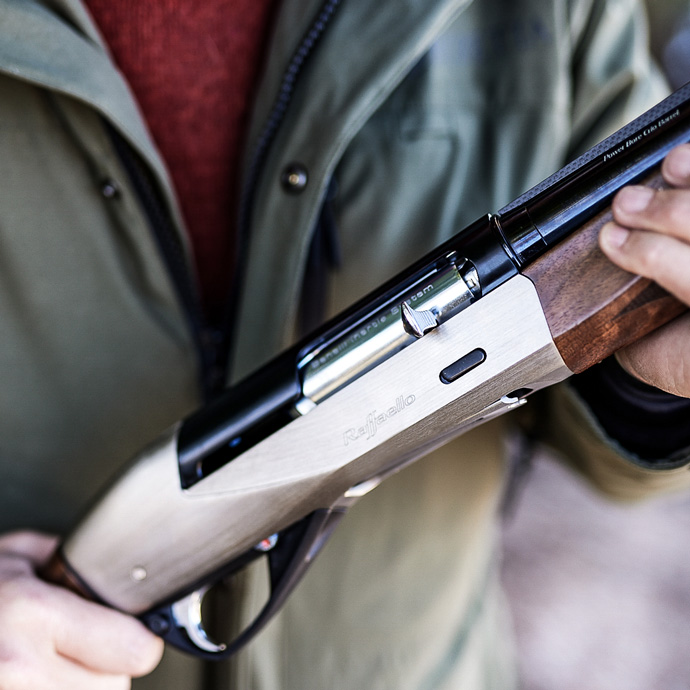03 February 2023
Wildfowl
Even with new types of hunting, hunting wildfowl has always been one of the most appreciated activities by true fans, often willing to make significant sacrifices to continue tasting the essence of traditional hunting.
Each species has its own peculiarities and, depending on the habitat, environment and characteristics of the wild, it will require specific hunting techniques and each of them, in their own way, with charm and tradition.
"Wildfowl" is a term that differentiates poultry fauna from the other large category of wildlife, the "big game", and can be divided into permanent and migratory.
Why a hunter prefers one type of hunting over another, however, it is and will always be a mystery.
What prompts a hunter to venture into the depths of intricate woods, the favourite abode of the Queen of the Woods, or to climb the highest peaks to hear the whisk of a rock ptarmigan, or even wait for the colors of dawn to dye the water mirrors to see a flight of northern pintail on the horizon?
Just as a musician does not completely choose his instrument, but it is the latter that somehow chooses him, so is hunting, although it is often handed down by family tradition or thanks to a friend, it is a particular typology that "chooses" the hunter. Like a call, magnetic and irrational.

Let's find out the different types of wildfowl hunting
Hunting sedentary wildfowl is generally practiced as hunting with pointing or stalking dog.
The beauty of this type of hunting lies in the great variety of environments and encounters that can happen on the same day of hunting. Not at all stiffened within formal schemes, a day of wandering hunt with dogs is an experience that takes shape from moment to moment, depending on the mood of the time and the game.
A fundamental element for a full and satisfying experience is the good work of our four-legged companions, which repays all the energy used to train them. The moment in which the muscles leap, tense and quiver for the statuesque pointing, just before the wild fly away, that's part of the beauty of the hunting.
The environment that enhances the dynamic and olfactory qualities of pointing dogs is the open countryside, while the characteristics will vary according to the wildfowl hunting technique and the habitat in which the game is found.
Partridge and pheasant are definitely among the most common species of sedentary wildfowl.
The grey partridge (Perdix Perdix) is a small, compact bird, with short, rounded wings and dominant plumage on the brown or cinnamon color, with grey areas on the chest, neck and beak. The two sexes are very similar and difficult to distinguish, except for the smaller size of the females.
In the countryside the grey partridge prefers to live near the thick hedges dividing the fields with different crops. It was widespread in cultivated areas throughout Europe until the 1950s, then the impoverishment of habitat, the disappearance of the environment suitable for nesting, food shortages and pollution led to a reduction.
In this hunt an aide with a solid pointing, which allows a slow approach, and a hunter who manages to dominate the emotions are fundamental aspects. The practice in the hilly environments typical of this wild provides for a wide turn with respect to your dog, with the prudence of making the aide always upstream to your position, because in most cases, especially if early in the morning, the grey partridges will return to the highest points, ready to fly downstream.
The pheasant (Phasianus Colchicus), on the other hand, is essentially divided into two large groups: Nordic, or “ring-necked,” and southern, or “black-necked” species.
Despite being among the major protagonists of the local hunting season, it is not an indigenous species, but an imported one. It is a medium-sized wild and with particularly appreciated meat. It is precisely for this reason that, according to tradition, the spread of pheasant to the West is due, first in Greece and Italy, then in France and Great Britain.
Its vocalization is a familiar sound to rural dwellers, especially at dawn and dusk. It is a mainly daytime wild, which does not come out before 8.00/8.30 in the morning. Smart and suspicious, they are able to test the skills of dogs and hunters, being able to escape even long kilometers and becoming naughtier as the hunting season goes on.
A typical behavior of this type of game is to flatten and walk, moving away on its legs, when it perceives a danger or a pointing dog.
When it takes off, which seldom happens, it usually does so almost never within shooting range, sometimes stopping behind the trees. For this reason, a tip is to dodge your aide with a wide circumference, positioning yourself in front to cut the pheasant any escape routes.
In addition to wandering hunt with dogs, another technique rich in charm and tradition is that of English drives, which see over-and-under shotguns as the weapon of choice. In this case, groups of beaters fly flocks of pheasants, usually in large numbers, which head in speed towards the hunters at the ambushes, testing their coldness and shooting ability.
Among the most fascinating species of sedentary wildfowl is undoubtedly the rock ptarmigan (Lagopus Mutus).
The peaks that stand out between the clouds and the sky are the favorite habitat of the ptarmigans, present in the massifs of the Alps at high altitudes. The characteristic that makes these animals unique is that they have the ability to “change clothes” by changing the colour of their plumage according to the seasonal changes of the soil, from brown and gray in spring-summer to pure white in winter, so as to camouflage themselves among the snow or among the sparse grasses and lichens of high altitude meadows.
The hunter and his aide must be athletically prepared and know the mountain well, because rock giants do not give anyone any discounts and the utmost caution is always required. The march usually begins in the middle of the night, because the best opportunity to spot the so-called “Snow Queen” is in the morning.
Another type of wildfowl hunting is chasing migratory game. A different hunting, for which knowledge of the periodic movements of the wild is required.
What makes it thrilling and never obvious are the weather phenomena and how much these affect the migratory routes. From quail to wood pigeon, from woodcock to thrushes, to waterfowl, there are many species included in this category of birds.
The woodcock (Scolopax Rusticola) is one of those that deserves a special mention. Enigmatic and fascinating, it is a wild about the size of a partridge and light-dark plumage. The hunt for the undisputed Queen of the Woods, the protagonist of much of the hunting literature, is intimate, solitary, challenging and magical together.
Tenacity and resistance to fatigue are the main ingredients for entering the intricate woods where it loves to hide. The empathy between dog and hunter must be total to evade the traps she will put in place, the ability to swing and to impeccable instinctive aiming shot, to face her sudden and zigzagging flight. The thrill of hearing the flutter will always be unique.
The hunt for wood pigeon (Columba Palumbus) is not among the most widespread, but it is certainly among the most heartfelt hunting traditions of our peninsula. It could be defined a real philosophy, which according to the hunting technique used can engage the hunter for a good part of the year, even in closed hunting season.
October is the month of choice for this wild, the month of the passage in which flocks of wood pigeons fly between the crossings or are attracted by flappers and decoys placed in sheds.
This species nests in trees, hedge shrubs and, more rarely, on the ground. It prefers woods or scrub and mature trees with dense foliage, often covered with ivy. Where tree vegetation is scarce, the wood pigeon is forced to nest on the ground, among the fields of heather or other tall grasses, in the middle of which it hides the nest.
This is little more than a platform, built by the female quite simply, with the shoots or other fragments carried by the male. The types of wood pigeon hunting include hunting at the pass, in which the hunters are positioned in the valleys between the mountains waiting to see a passage of pigeons and the distant and vertical shots, or fixed hide.
This can be from hut or from the ground, with the help of live or mechanized call backs, being very careful to take all the necessary precautions to ensure total camouflage.
Hut hunting, on the other hand, is perhaps one of the most fascinating forms of wildfowl hunting to the so-called “wood pigeon,” typical of the regions of central Italy.
The care of the hut and the training of the decoys are essential aspects, to enjoy the emotion of a group of Amelie or Terni pigeons that like an orchestra of musicians will fly in synchrony at the command of the hunter to attract the wood pigeons to the game.
Among the most coveted migratory wilds there is definitely the thrush, hunted both as a wandering and still hunt that requires attention to detail, especially if you are a shedman, and great shooting skill.
The most common and widespread variety is the song thrush (Turdus philomelos), present in Italy from the beginning of October until March. Medium-small in size and well-balanced in shape, it has a dark-brown back and a creamy-white belly, with the breast tending to reddish yellow.
In autumn-winter it frequents vineyards, orchards, olive groves and the Mediterranean scrub, while it winters in the central and southern regions in September-October. The return movements take place from January until April-May. As a nesting animal, it is widely spread over all the reliefs of northern Italy, Alpine and pre-Alpine, and the central-northern Apennines.
From the same family as the previous one, the redwing (Turdus Iliacus) differs for the plumage that, in both sexes, is dark-olive-coloured on the back and white-reddish with dark streaks in the lower parts of the body.
It is a territorial species, monogamous and gregarious, especially in the period of migrations, which takes advantage of the weather conditions to make migratory movements, to the point that the winds not only affect the times and migratory routes, but even determine the choice of wintering places.
Using wind thrust, migrators save energy and are able to maintain very high speeds, thus reducing the time needed to cross stretches of sea.
In Italy, it is a regular migrant, with double passages, in October-November and in February-March.
Irregular nesting, it winters throughout the national territory, especially in the central regions, on the Tyrrhenian side in particular. It is linked to flat or hilly environments, where it frequents the Mediterranean maquis, the margins of cultivated fields and deciduous woods.
Hunting thrush is one of the types of wildfowl hunting, that can be done in many ways: inbound from the hides, to the “spollo”, to the tracing, to the return and from the hut with the live calls.
The first technique is practiced about 15-20 days a year. Mimicry and calling game are essential to not be identified by thrushes incoming towards the hide and attract them close to the game of lures. At that point it is all a matter of coldness and timing, and the hunter, usually positioned near oaks, olive trees or even better oranges, will have to capture the perfect moment with shots that typically range from 25 to 20 meters.
The “spollo” hunt, on the other hand, is made at the first light of dawn, when the wilds go to the places of pasture, arriving suddenly as lightning bolts on the blue of the sky. Fast shots and at a short distance, manoeuvrable shotguns and shooter skill are ingredients that give beautiful emotions.
Another facet of the “spollo” medal is the return hunt, an afternoon hunt in which hunters on the edge of the spot or near the canals can shoot at close distances or at the limit of the range.
The technique at the shed is still different, with a job of managing the hiding similar to the wood pigeon’s, which lasts throughout the year and relies on the help of live calls, trained throughout the season.
Another type of extremely specific wildfowl hunting that requires unconditional passion and great technical knowledge is certainly the hunting of aquatic animals.
The migratory species which are among the anatids are numerous: from snipe at duck, from the coot to the northern pintail, to teal and eurasian wigeon and the list goes on and on.
A typical day of winter waterfowl hunting can start before dawn when hunters make their way to a swamp or body of water, where flocks of ducks are expected; others, on the other hand, visit places where meeting others migrators is frequent .
Once the morning passage is over and the heads recovered thanks to the help of the dogs, it's usually time for a break and a good coffee in the thermos to face the cold. Different waterfowls have different habitats obviously. In the vicinity of the swamps, for example, there are frequent morasses where the snipes and various other wading birds stop, not to mention that a teal can always come in range.
The waterfowl hunting is mainly carried out in the lake areas near Ferrara, Ravenna or the Venetian Lagoon; even the swampy areas of Tuscany are quite appreciated by these waterfowls.
The most commonly used waterfowl hunting techniques are three: wandering hunt with the dog, from hut on the mainland or from stalking in the barrel. The first involves approaching the prey walking on the banks or between the reeds, while for the hut on the ground you can go from the simple screen of reeds on the shore to a body of water to the fixed position on a tree.
For hunting duck a metal mesh screen masked with rushes may also suffice: high enough to hide the figure of the hunter, however, it must allow for easy and rapid aiming. The choice of place affects the effectiveness of the hide: it must be in the vicinity of a typical place of passage or pasture.
A hut, but a shelter is also enough to repair the hunter and the retriever, must be arranged taking into account the prevailing wind and the range of the shotgun.
On the coast the passage in flight of flocks is more extemporaneous and the possibility of intercepting one must be evaluated from time to time according to the presence e ducks parked offshore and grazing areas immediately close to the coast.
Hunting position can vary continuously and, therefore, more than a fixed structure you need to be ready to improvise shelters with camouflage cloths.
Barrel hunting is considered, in our country, the typical way to hunt ducks. The hunter hides among the vegetation, taking care to perfectly camouflage itself and the barrel, almost completely immersed, leaving a few centimeters above the surface of the water.
The hunter must only stand in the barrel, camouflage himself with branches and bushes and wait for the ducks to pass.
It can be said that wildfowl hunting techniques are those that are part of our historical hunting tradition.
The 28 Magnum gauge lends itself absolutely fine to hunting with the dog, because thanks to its low weight it is a fast shotgun to the shouldering, extremely maneuverable and perfect for shots and long walks in the hills to grey partridge, pheasant or quail.
Challenging and elegant, it is a gauge for true connoisseurs, skilled hunters with years of hunting behind them, who are enthusiastic about a more complex and equal challenge with the wild, but possess the necessary experience to know how and when to shoot so as to not miss the target and lead the hunt to the utmost of ethics.

Here's the list of Benelli 28-gauge semi-automatics for wildfowl hunting:

14/02/2025
Benelli Wins the Assoarmieri Award 2025 in Four Categories
As every year, Benelli participated in the EOS Show, the exhibition dedicated to hunting, sport shooting, and outdoor disciplines. This even...

11/07/2024
Benelli Advanced Impact: best technology in 2023
The "Trophées Connaissance de la Chasse" awarded to Benelli Armi S.p.A. for its Benelli Advanced Impact technology. France - Benelli Armi S.p.A...

13/06/2024
The best smooth barrel shotguns of 2024 are Benelli
Benelli wins the Shooting Sports Retailer "GOLD Award" in the shotgun - smooth barrel shotguns category. As in previous years, the American mag...



